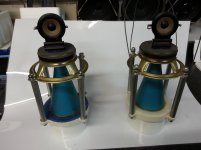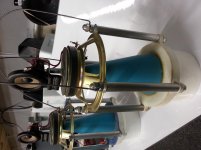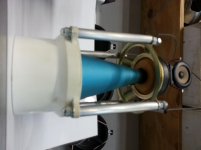Very interesting, I am about to tackle the same project. Just acquired a pair of WTLCs. Spent many many hours with them driven with GAS equipment in the 70s so I knew them well. Aside from the filler and the termination at the end of the cone, the material and method they are dampened must be one of the most import single items in producing the sound they were known for. They will either be too bright or dead. Question, as with the use of employng dissimilar materials in the construction of the cone, has anyone played with dissimilar materials as fillers in layers moving up the cone to the cap ? Would that affect the linear response of the wave or help tune the frequency response ? Thinking that there appears to be a mix of materials as opposed to a single catch-all filler.
The termination is extremely important as seen in my clone of the mbl speaker. I use pretty esoteric materials which might be a little too advanced to get readily but diaphragm material has to be a rigid light material with good damping. Carbon can meet these three with enough care. stiffness is attenuated by the angle of the cone and thus different velocities. It will only effect the frequency response if you take into account stiffness. The wave at the end of the speaker is like a literal wave hitting a wall think of how you would reduced that back splash.
Already posted in the MBL clone thread, maybe also interesting here:
DC Gold drivers have polymer baskets (good for slaughtering) an voice coils that touch the pole-piece (teflon on teflon), what abandons the annoying voice coil centering problems.
Home :: DC Gold Audio ::
An interesting material for the cone:
Task Board, Model Making Cardboard
On the second video someone is knocking on it.
This is no longer used in the dc gold speakers. They speakers rubbed at low volumes a spider is ok here even ferro-fluid.
good question!
walsh and german physics are not the same speaker
I think you mean low density which gives a higher wave velocitythe infinity walsh tweeters are transmission line drivers and not dynamic drivers. they do not move air like a dynamic speaker. they are more akin to the bending wave driver. the key is to have a very thin cone material with low mass, but extremely high rigidity. low mass for ease of acceleration. rigidity to hold its form, and high density to allow for very fast propagation through the cone material. in the case of the infinity tweeter, propagation speed is 3 to 4 times the speed of sound in air (1,128 ft/sec).
the cone angle is a bit of math, but suffice it to say the angle is chosen to produce a cylindrical wave front that is perfectly vertical in nature emanating from the cone. it also, assures time and phase coherence.
the original tweeters used aluminum foil off the shelf. some was diamond foil and some was scribed. the purpose of the diamond or the scribing was to stiffen the foil, since most aluminum foil off the shelf has been annealed and is very soft. this does not bode well for the bending wave driver and can cause the cone to fold up or crush under high loads. the production drivers were very simple consisting of one layer of foil with about .0015" to .002" thickness. X-max [linear cone excursion] was on the order of + / – .004" without damage.
there is a big walsh tweeter thread over at audiokarma that has a ton of info on the subject:
walsh tweeter design/rebuild - AudioKarma.org Home Audio Stereo Discussion Forums
.
Hi,
Is there any research about the cone angle of this thing? I mean, the differences among the factors of cone angles, dimensions, overall shapes, and the performance.
Being a bending wave device and a cone with such a steep angle, I suppose the vibrations would be very largely bell mode. In other types of bending wave devices, their dispersions are also very wide (and almost omni). So What would be the benefit? Does this utilize the axial motion better, so it coworks better with box tuning?
Is there any research about the cone angle of this thing? I mean, the differences among the factors of cone angles, dimensions, overall shapes, and the performance.
Being a bending wave device and a cone with such a steep angle, I suppose the vibrations would be very largely bell mode. In other types of bending wave devices, their dispersions are also very wide (and almost omni). So What would be the benefit? Does this utilize the axial motion better, so it coworks better with box tuning?
Hi,
Is there any research about the cone angle of this thing? I mean, the differences among the factors of cone angles, dimensions, overall shapes, and the performance.
Being a bending wave device and a cone with such a steep angle, I suppose the vibrations would be very largely bell mode. In other types of bending wave devices, their dispersions are also very wide (and almost omni). So What would be the benefit? Does this utilize the axial motion better, so it coworks better with box tuning?
From I have seen no this is their secret formula and pretty advanced mathematics to boot. I do know of a simple calculator that along with some measurements could help developing this. the motion is a wave down the speaker not side to side. The brilliancy is the speed the voice coil doesn't have to "move" the cone simply bend it thus extremely fast impulses the cone would weight tenths of the actual weight. I wouldn't use it with a box.
Exactly as i said in post #47 it can however go fairly low think of a dynamic fullrangeThanks for the info, but a steep cone like this has a very high stiffness along the radial (or nearly the axial) direction.
So I'd guess the bending wave along the radius can only happen in very high frequency. In the lower range, it'd be inevitably moved axially.
My offer for a copy of the Walsh patent is still good. If anyone can explain to me how to post a .pdf file here, I will happily do so.
The patent explains a lot about cone angle, propagation velocity, damping and termination.
Certainly there have been many improvements in material and technology since the '60's. Modern computer modeling has also undoubtedly taken a lot of the mystery out of the "cone's" behaviour.
FIY, Radio Shack offered a tweeter that looked very much like the Walsh many years back, as did a couple of other companies.
The patent explains a lot about cone angle, propagation velocity, damping and termination.
Certainly there have been many improvements in material and technology since the '60's. Modern computer modeling has also undoubtedly taken a lot of the mystery out of the "cone's" behaviour.
FIY, Radio Shack offered a tweeter that looked very much like the Walsh many years back, as did a couple of other companies.
My offer for a copy of the Walsh patent is still good. If anyone can explain to me how to post a .pdf file here, I will happily do so.
The patent explains a lot about cone angle, propagation velocity, damping and termination.
Certainly there have been many improvements in material and technology since the '60's. Modern computer modeling has also undoubtedly taken a lot of the mystery out of the "cone's" behaviour.
FIY, Radio Shack offered a tweeter that looked very much like the Walsh many years back, as did a couple of other companies.
Click on Go Advanced
Select paper clip to the right fo the white happy face icon
attachments
browse your directory and click upload
done
Cretinish, no CREATIVE play...
Well, hi there, Cochleus. I figured somebody's still wandering in and wondering if anyone has been goofing about with the DECware/Conus approach to 'creative speaker repurposing'. Well, guilty...'course, I did these some 8 years ago. Dug them out of storage from moving 5 times in that interval. Finally have the space and motivation to push on to 'bigger/better/louder/all that...
"Submitted for your consideration", as Rod Sterling used to say...
The blue/green cones still make me grin.
Well, hi there, Cochleus. I figured somebody's still wandering in and wondering if anyone has been goofing about with the DECware/Conus approach to 'creative speaker repurposing'. Well, guilty...'course, I did these some 8 years ago. Dug them out of storage from moving 5 times in that interval. Finally have the space and motivation to push on to 'bigger/better/louder/all that...
"Submitted for your consideration", as Rod Sterling used to say...
The blue/green cones still make me grin.
Attachments
- Home
- Loudspeakers
- Planars & Exotics
- DIY Walsh driver revisited
 pulled some posts, please hit the message and not the messenger or else someone's going to read only mode....
pulled some posts, please hit the message and not the messenger or else someone's going to read only mode....

